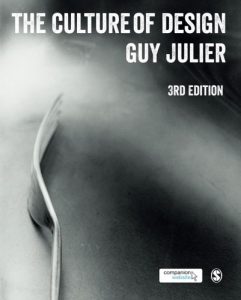The Culture of Design, 3rd revised edition.
Sage Publications
Publication: December 2013
3rd edition:
new sections and chapters marked in magenta;
substantially revised sections marked in green
introduction
one design culture
Design culture as an object of study – Beyond Visual Culture: Design Culture as an academic discipline – Models for studying Design Culture – Design Culture beyond discipline?
two design and production
The rise of design – Freelance, in-house and consultancy design – The establishment of design consultancy – The 1980s design consultancy boom – Neo-Fordist design – Post-Fordist design – Towards a brand ethos – Speeding up design and production – Design within disorganized capitalism – The new economy – Conclusion
three designers and design discourse
Definitions of design – The word ‘design’ in history – The professional status of design – Designers as ‘cultural intermediaries’ – Historicity and modernism in design discourse – Second modernity versus design management – Service design – Design Thinking – Conclusion
four the consumption of design
The culture of consumption -Design and consumer culture – Passive or sovereign consumers? – De-alienation and designing – Commodities and the aesthetic illusion – Systems of provision – Circuits of culture – Designers and the circuit of culture – Writing about things – Consumption and practice – Conclusion
five high design
Anomalous objects – High design – Design classics – Mediating production – Consuming postmodern high design: Veblen and Bourdieu – Historicity – Modern designers/modern consumers – Designers, risk and reflexivity – Critical design – Design art – Conclusion
six consumer goods
Images – Surfaces – Doing the Dyson – Product semantics – Mood boards – Lifestyles and design ethnography – Back to the workshop – Product semantics and flexible manufacture – Designing global products – Product designers and their clients – Products and brand image – Product use – The iPod: consumption, practice and contingency – Conclusion
seven branded places
Evaluating place: beyond architectural criticism – The Barcelona paradigm – Cultural economies, regeneration and gentrification – Museums and post-industrial place-making – Beyond nation-states: cities and regions – The branding of city-regions and nations – Problematizing the branding of place – Conclusion
eight branded leisure
From Fordist to disorganized leisure – Time-squeeze and packaged leisure – The Disney paradigm – Post-tourists – Naked and nowhere at Center Parcs – Televisuality and designing leisure experiences – Dedifferentiation/distinction – Conclusion
nine on-screen interactivity
Computers and graphic design – Technological development – Professional practices – Critical reflection – Authorship – Readership – Consuming interactivity – Cybernetic loss – Liberation and regulation: the bigger picture – Bytes and brands – Conclusion
ten communications, management and participation
Internal brand building – The end of advertising – Brand and communications consultancy – Employees as consumers – Aesthetic labour – Designing for creativity – Social participation and design activism – Conclusion
eleven networks and mobile technologies
iPhones and smartphones – Cyborgs – Closed and open networks – Cultural relativism and technological change – The competition of monopolies – Scripts and metadata – Agencement and dispositive – Assemblage – Articulation – Boundary objects and spaces – Conclusion
twelve studying design culture
A design culture turn – Writing design culture – Scope – Closed and open conceptions of design – Reflexivity and historicity – Mediation – Density – Dynamics – Materiality – Concluding remarks
References
Index
